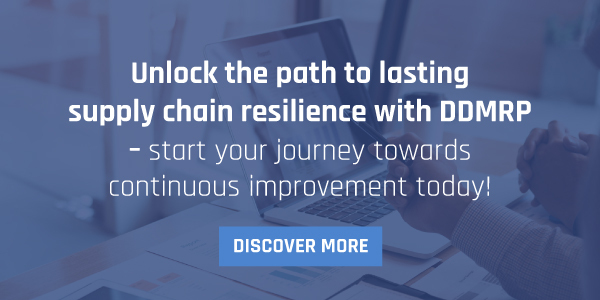
The Role of DDMRP in Streamlining Supplier and Customer Communication
September 13, 2024
How DDMRP Turns Traditional Replenishment into a Competitive Advantage
October 4, 2024In today’s complex supply chain environments, achieving seamless collaboration among cross-functional teams is critical. With the increasing demands of customers and the dynamic nature of global supply chains, businesses need robust tools and strategies to ensure efficient coordination between departments. One such tool is DDMRP. This article explores the best practices for leveraging DDMRP to enhance collaboration, improve departmental coordination, and contribute to effective supply chain and inventory management.
Introduction to DDMRP and Cross-Functional Team Collaboration
What is DDMRP?
DDMRP is an advanced planning methodology designed to manage inventory and production more efficiently by responding to real-time demand signals. Unlike MRP, which often leads to excessive inventory or shortages due to forecast inaccuracies, DDMRP focuses on actual demand, enabling supply chains to become more flexible and responsive.
Why Cross-Functional Collaboration Matters?
When departments like procurement, production, sales, and logistics work in silos, it can lead to miscommunication, inefficiencies, and costly errors. Without effective collaboration, companies often face challenges such as stockouts, excess inventory, missed deadlines, and poor customer satisfaction.
Cross-functional collaboration ensures that each department is aligned with the company’s overarching goals. For instance, procurement teams can better plan for material needs when they have clear visibility into production schedules and sales forecasts. Similarly, production and logistics teams can work together to ensure on-time delivery, reducing costly delays and inefficiencies.
DDMRP plays a pivotal role in enhancing collaboration by providing real-time data visibility and integrating processes across departments. With DDMRP, teams can access accurate, up-to-date information, enabling them to make informed decisions quickly and efficiently. This leads to better coordination, fewer errors, and improved overall performance. Ultimately, cross-functional collaboration facilitated by DDMRP helps businesses achieve greater agility, reduce operational costs, and enhance customer satisfaction—key factors in
How DDMRP Facilitates Better Teamwork?
Here’s how DDMRP strengthens teamwork across procurement, production, sales, and logistics.
Real-Time Data Visibility for Informed Decision-Making
One of DDMRP’s greatest strengths is its ability to offer real-time data visibility to all stakeholders. This shared access to accurate, up-to-the-minute information enables cross-functional teams to make well-informed decisions quickly. For example, procurement teams can monitor inventory levels in real time, allowing them to act proactively when buffer levels drop, thereby preventing potential stockouts. In parallel, the sales team can adjust customer commitments based on the available inventory, ensuring that promises are grounded in current supply conditions. This real-time data integration reduces the risk of errors or delays, as each department operates from the same set of facts, creating a more unified and responsive organisation.
By providing visibility into demand fluctuations and inventory positions, DDMRP ensures that decision-making is driven by actual demand rather than unreliable forecasts. This allows for more accurate planning, minimises waste, and ensures that teams can react swiftly to changing conditions in the market.
Reducing Silos Between Departments
In many organisations, departments often function in isolation, leading to fragmented decision-making and inefficiencies. These silos can result in procurement ordering excessive materials while production and sales teams are unaware of impending supply chain disruptions. DDMRP addresses this challenge by integrating planning processes and creating real-time feedback loops that encourage collaboration.
With DDMRP, all departments—procurement, production, logistics, and sales—work from the same data set. This harmonisation eliminates misunderstandings and conflicting objectives. Instead of operating with disparate goals, departments can align around common targets, such as optimising buffer levels, reducing lead times, or improving on-time delivery rates. The shared data fosters a team-centric approach, where departments work together rather than in isolation, driving greater efficiency throughout the supply chain.
Improving Communication Flows Across Teams
Effective communication is key to cross-functional collaboration, and DDMRP provides a common language for all teams to use. By focusing on buffer management, demand signals, and real-time data, DDMRP standardises communication and ensures that everyone is discussing the same metrics and goals. This clarity reduces confusion, eliminates the guesswork, and helps all departments stay aligned.
For instance, when production schedules change due to a shift in demand, this information is immediately available to both procurement and sales. Procurement can adjust their orders accordingly, and sales can manage customer expectations with realistic timelines. This shared understanding creates a smoother flow of communication, resulting in faster decision-making and fewer disruptions.

Enhancing Coordination Through Buffer Positioning
Buffer positioning is a cornerstone of DDMRP, designed to enhance coordination and streamline operations across the supply chain. By strategically placing buffer zones throughout the supply chain, DDMRP ensures that cross-functional teams can work together more effectively, maintaining optimal inventory levels and preventing disruptions. Here’s how buffer positioning in DDMRP fosters better coordination among departments and strengthens overall supply chain efficiency.
Understanding Buffer Zones in DDMRP
Buffer zones are critical components in DDMRP, serving as safety stocks that absorb demand variability and ensure smooth operations. These buffers are strategically placed at key points in the supply chain, such as raw materials, common intermediate components, and finished goods. By doing so, they act as a buffer between fluctuating customer demand and the supply chain’s capacity to meet that demand.
Buffers help mitigate the risks of both shortages and overstocking. For instance, when demand surges unexpectedly, the buffer absorbs the extra demand without immediately impacting production schedules. Similarly, if demand drops, the buffer prevents overproduction, allowing companies to avoid excess inventory that could tie up capital. This flexibility is crucial in maintaining a balance between demand and supply, especially in unpredictable markets.
Aligning Departmental Objectives Through Buffer Management
In a DDMRP environment, effective buffer management requires collaboration between various departments, including procurement, production, and logistics. Each department has a specific role in maintaining the health of the buffer zones, ensuring that overall objectives are aligned.
For example, the procurement department is responsible for ensuring that raw materials are available to replenish buffers at the right time. Production teams, on the other hand, focus on maintaining appropriate work-in-progress levels to prevent bottlenecks, while logistics ensures that finished goods are available to meet customer demand. By aligning their efforts around the same buffer zones, these departments coordinate their actions, ensuring the right balance of materials and resources at each stage of the supply chain.
This alignment of departmental goals enhances the overall efficiency of the supply chain. Instead of working in isolation, each department operates with a clear understanding of how their actions impact the buffers and the broader supply chain. This collaborative approach helps avoid delays and shortages, leading to smoother operations and improved performance.
How Buffer Zones Streamline Operations Across Functions
The use of buffer zones streamlines operations by ensuring that all departments have the resources they need to perform their tasks efficiently. For production teams, buffer zones help prevent delays caused by missing materials. When raw material buffers are properly managed, production teams can maintain a steady workflow without waiting for supplies. This reduces lead times and increases production reliability.
For sales teams, the existence of buffer zones allows for more accurate customer promises. With real-time visibility into buffer levels, sales teams can provide realistic delivery dates, reducing the likelihood of overpromising or under delivering. This enhances customer satisfaction, as orders are more likely to be fulfilled on time and as promised.
In logistics, buffer zones provide flexibility in handling shipping schedules. When inventory levels are well-managed, logistics teams can ensure timely deliveries to customers without rushing shipments or paying premium costs for expedited transportation. This coordination between departments ultimately leads to reduced costs, faster response times, and improved service levels.

Promoting a Culture of Continuous Improvement
Continuous improvement is essential for maintaining a successful, agile supply chain. DDMRP helps foster this mindset by creating feedback loops between teams, allowing for ongoing assessment and refinement of processes.
Using DDMRP to Drive Feedback Loops Between Teams
DDMRP naturally encourages collaboration and communication between departments through real-time data and buffer management. This integration creates constant feedback loops that help teams make continuous adjustments. For instance, production teams can inform procurement when materials are running low, enabling proactive replenishment. Meanwhile, sales teams can provide early warnings to logistics about demand surges, allowing for better resource planning. These feedback loops ensure that all teams remain aligned and that potential issues are addressed before they escalate, creating a cycle of continuous improvement across the supply chain.
Monitoring and Measuring Team Performance with KPIs
To ensure that DDMRP-driven collaboration is effective, teams should regularly monitor key performance indicators (KPIs). Metrics such as inventory turns, stockouts, lead times, and buffer status provide insight into the supply chain’s health and performance. By analysing these KPIs, teams can pinpoint inefficiencies and make informed, data-driven decisions to optimise operations. Continuous review of these metrics not only highlights areas for improvement but also enables teams to measure the success of adjustments and enhancements.

Adapting to Change with an Agile and Responsive Approach
Supply chains are constantly evolving, and adaptability is crucial for success. DDMRP’s focus on actual demand rather than forecasts allows teams to remain agile. By responding to real-time demand signals, departments can adjust swiftly to changes, whether they are driven by customer demand fluctuations or external disruptions. This adaptability fosters resilience and ensures that cross-functional teams can meet evolving challenges while maintaining operational efficiency and customer satisfaction.
Overcoming Challenges in Cross-Functional Collaboration
While DDMRP offers significant benefits in improving cross-functional collaboration, it also presents challenges. Organisations must address these obstacles to fully leverage DDMRP’s potential.
Identifying and Addressing Common Pitfalls
Common pitfalls in implementing DDMRP include resistance to change, misalignment of departmental goals, and a lack of trust between teams. These issues often arise when departments are accustomed to working in silos or when there is insufficient communication. Overcoming these challenges requires creating a culture that values collaboration. Providing proper training is essential to ensure that all teams understand the principles of DDMRP and how to use it effectively. Additionally, fostering transparency about the benefits of DDMRP and aligning departmental goals with organisational objectives can help bridge gaps between teams.
How to Encourage Collaboration Among Diverse Teams
Cross-functional collaboration does not happen naturally, especially in organisations with diverse teams. Leaders play a critical role in fostering a collaborative culture by encouraging open communication, transparency, and shared goals. DDMRP can be a strong foundation for this collaboration, as it aligns departments around common metrics like buffer levels and demand signals. However, leadership needs to actively promote teamwork by ensuring that all departments understand the shared objectives and the importance of working together. Building trust among teams is essential, and that trust is strengthened when each department sees the value of collaboration through better results.
Tools and Techniques to Facilitate Continuous Communication
Effective communication is the backbone of cross-functional collaboration. Regular meetings and open communication channels are key to keeping everyone informed and aligned. Shared platforms, like collaborative planning software or real-time dashboards, allow teams to access up-to-date data and provide transparency across departments. These tools make it easier for teams to work together, identify issues early, and adjust their actions accordingly, ensuring smooth and continuous collaboration.
The Role of Leadership in Fostering Cross-Functional Success
Effective leadership is vital for fostering cross-functional collaboration, particularly in environments that rely on DDMRP. Leaders set the tone for teamwork, breaking down silos and promoting alignment across departments to achieve shared objectives.
Leadership Best Practices for Supporting Collaborative Teams
Leaders must actively promote cross-functional objectives to ensure the success of DDMRP implementation. Encouraging open communication, transparency, and collaboration helps bridge gaps between departments such as procurement, production, and logistics. Leadership support is especially important during the cultural shift that DDMRP requires, as teams accustomed to working independently must now operate in a coordinated manner. Leaders can facilitate this transition by clearly communicating the benefits of DDMRP and supporting the tools and training needed for effective use.

Establishing Accountability and Ownership Across Departments
In a DDMRP-driven environment, accountability is a cornerstone of success. Leaders should ensure that each department understands its role in the overall supply chain and takes full ownership of its responsibilities. Procurement, production, sales, and logistics must each recognize how their performance affects the broader organisation. By establishing accountability, leaders create an environment where teams work collaboratively to optimise supply chain performance, with each department contributing to shared goals like buffer management, lead time reduction, and service level improvement.
How Leaders Can Foster a DDMRP-Driven Culture
Leaders play a key role in fostering a DDMRP-driven culture by setting clear expectations and ensuring departments have the necessary resources. Ongoing training, access to real-time data, and collaboration tools are essential for maintaining high performance. Regular performance reviews, combined with continuous feedback loops, help reinforce the importance of collaboration, keeping all teams aligned with the company’s broader supply chain strategy. Leaders who emphasise the value of cross-functional teamwork and continuous improvement set the foundation for a successful, DDMRP-driven organisation.
Conclusion
Implementing DDMRP to enhance cross-functional collaboration offers significant benefits for improving supply chain efficiency. By fostering real-time data visibility, aligning departmental goals through buffer management, and encouraging continuous feedback loops, DDMRP helps break down silos and strengthen teamwork. Effective leadership plays a critical role in creating a culture of collaboration, accountability, and adaptability, ensuring that all teams work toward shared objectives. With the right support, training, and communication tools in place, DDMRP can transform supply chain operations, leading to better coordination, reduced costs, and improved customer satisfaction.
Explore best practices for using DDMRP to boost cross-functional team collaboration.





